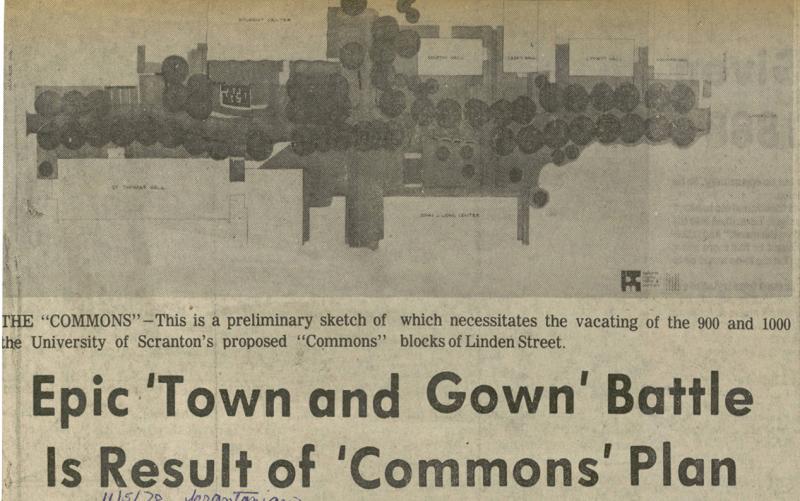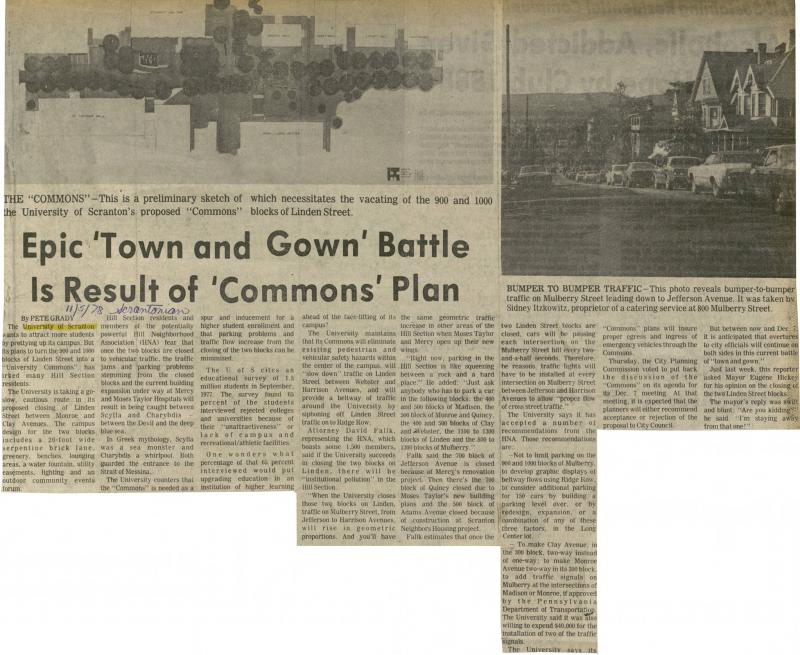Epic 'Town and Gown' Battle Is Result of 'Commons' Plan, 1978
Item
- Title
- Description
- Date
- Creator
- Subject
- Source
- Record Identifier
- Exhibit Section
- Copyright
- Transcript
-
Epic 'Town and Gown' Battle Is Result of 'Commons' Plan, 1978
-
Scrantonian article regarding plans to turn a portion of Linden Street into the University of Scranton Commons.
-
1978-11-05
-
University of Scranton Archives
-
univscrapbook-b044_0235a
-
Times Shamrock Communications
-
[Please note that computer-generated transcripts include formatting, spelling, and grammatical irregularities and errors.]
THE "COMMONS"-This is a preliminary sketch of the University of Scranton's proposed "Commons" which necessitates the vacating of the 900 and 1000 blocks of Linden Street.
Epic 'Town and Gown' Battle Is Result of 'Commons' Plan
By PETE GRADY
The University of Scranton wants to attract more students by prettying up its campus. But its plans to turn the 900 and 1000 blocks of Linden Street into a "University Commons" irked many Hill Section residents.
The University is taking a go-slow, cautious route in its proposed closing of Linden Street between Monroe and Clay Avenues. The campus design for the two blocks includes a 20-foot wide serpentine brick lane, greenery, benches, lounging areas, a water fountain, utility easements, lighting and an outdoor community forum.
Hill Section residents and members of the potentially powerful Hill Neighborhood Association (HNA) fear that once the two blocks are closed to vehicular traffic, the traffic jams and parking problems stemming from the closed blocks and the current building expansion under way at Mercy and Moses Taylor Hospitals will result in being caught between Scylla and Charybdis - between the Devil and the deep blue sea.
In Greek mythology, Scylla was a sea monster and Charybdis a whirlpool. Both guarded the entrance to the Strait of Messina.
The University counters that the "Commons" is needed as a spur and inducement for a higher student enrollment and
that parking problems and traffic flow increase from the closing of the two blocks can be minimized.
The U of S cites an educational survey of 1.5 million students in September, 1977. The survey found 65 percent of the students interviewed rejected colleges and universities because of their "unattractiveness" or lack of campus and recreational/athletic facilities.
One wonders what percentage of that 65 percent interviewed would put upgrading education in an institution of higher learning ahead of the face-lifting of its campus?
The University maintains that its Commons will eliminate existing pedestrian and vehicular safety hazards within
the center of the campus, will "slow down" traffic on Linden Street between Webster and Harrison Avenues, and will
provide a beltway of traffic around the University by siphoning off Linden Street traffic on to Ridge Row. Attorney David Fallk, representing the HNA, which boasts some 1,500 members, said if the University succeeds in closing the two blocks on Linden, there will be "institutional pollution" in the Hill Section.
"When the University closes those two blocks on Linden, traffic on Mulberry Street, from Jefferson to Harrison Avenues, will rise in geometric proportions. And you'll have the same geometric traffic increase in other areas of the Hill Section when Moses Taylor and Mercy open up their new wings.
"Right now, parking in the Hill Section is like squeezing between a rock and a hard place." He added: "Just ask
anybody who has to park a car in the following blocks: the 400 and 500 blocks of Madison, the 500 block of Monroe and Quincy, the 400 and 500 blocks of Clay and Webster, the 1100 to 1300 blocks of Linden and the 800 to 1300 blocks of Mulberry."
Fallk said the 700 block of Jefferson Avenue is closed because of Mercy's renovation project. Then there's the 700
block of Quincy closed due to Moses Taylor's new building plans and the 500 block of Adams Avenue closed because
of construction at Scranton Neighbors Housing project.
Fallk estimates that once the two Linden Street blocks are closed, cars will be passing each intersection on the
Mulberry Street hill every two- and-a-half seconds. Therefore, he reasons, traffic lights will have to be installed at every intersection on Mulberry Street between Jefferson and Harrison Avenues to allow "proper flow
of cross street traffic."
The University says it has accepted a number of recommendations from the HNA. Those recommendations are:
-Not to limit parking on the 900 and 1000 blocks of Mulberry, to develop graphic displays of beltway flows using Ridge Row, to consider additional parking for 150 cars by building a parking level over, or by redesign, expansion, or combination of any of these three factors, in the Long Center lot.
- To make Clay Avenue, in the 300 block, two-way instead of one-way: to make Monroe Avenue two-way in its 300 block, to add traffic signals on Mulberry at the intersections of Madison or Monroe, if approved by the Pennsylvania Department of Transportation. The University said it was also willing to expend $40,000 for the
installation of two of the traffic signals.
"Commons" plans will insure proper egress and ingress of emergency vehicles through the Commons.
Thursday, the City Planning Commission voted to put back the discussion of the "Commons" on its agenda for
its Dec. 7 meeting. At that meeting, it is expected that the planners will either recommend acceptance or rejection of the proposal to City Council.
But between now and Dec. 7, it is anticipated that overtures to city officials will continue on both sides in this current battle of "town and gown."
Just last week, this reporter asked Mayor Eugene Hickey for his opinion on the closing of the two Linden Street blocks.
The mayor's reply was swill and blunt: "Are you kidding?" he said. "I'm staying away from that one!"
BUMPER TO BUMPER TRAFFIC-This photo reveals bumper-to-bumper traffic on Mulberry Street leading down to Jefferson Avenue. It was taken bv Sidney Itzkowitz, proprietor of a catering service at 800 Mulberry Street.
- Item sets

